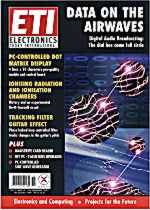

|
Electronics Today Contents |

Digital Audio Broadcasting (DAB) radio is poised to take over from analogue broadcasting – when the price of radio receivers comes down. Mike Bedford shows how the newest transmission techniques hark back to methods in use since the early days of radio.
Robin Abbott applies his routines to make an 8-pin I2C bus eeprom programmer and reader.
A self extracting zip file containing the software is available for download. It will extract under DOS or in a DOS box under Windows.
This unusual guitar effect by music maestro Robert Penfold uses a phase locked loop and switched capacitor filter to track changes in the guitar's pitch.
John Howden has developed a method of using an everyday spreadsheet to simulate component interactions in a circuit design, applying the spreadsheet's ability to do instant calculations.
The first of three articles describing Robert Coward's modular display system with four multicoloured 24-character display lines and a display management board. The system can be built into a constructed enclosure, or into a flight case for easy transit.
You can use a PC to look at what is encoded onto the mysterious dark stripes of, say, loyalty cards, or even credit cards. Patrick Gueulle's software provides an interface to TTL card readers.
This PC-based temperature and humidity measuring device by Pei An uses standalone LCD temperature and humidity modules and a choice of Turbo Pascal or VisualBasic drivers.
Industry makes extensive use of barcodes to identify goods. Roger Thomas explains the principles behind commercial barcoding and how to decode EAN-13 barcodes using a low cost barcode reader wand and a PIC interface to a PC.
Fear of the danger from ionising radiation have led to many techniques for measuring levels. Douglas Clarkson examines the history and science of the ionisation chamber, and provides a circuit for the experimental measurement of background radiation.
Owen Bishop describes how to drive real-time clock, elapsed time clock and process timer displays from timing circuits.
Among other things, we look at Flash BIOS upgrades and the pros and cons of upgrading to a Pentium II.
This sine wave project by Mark Roberts of Softmark plugs into the PC printer port to work as an accurate audio generator. The accompanying software generates the on-screen display and allows adjustment of the generator settings.
Raymond Haigh's adapter circuit allows the Q factor and inductance of RF coils to be measured with a low-impedance output signal generator and a high-impedance electronic multimeter.
Terry Balbirnie's alarm was originally designed for his caravan, but can be used for any number of articles that can be "looped" with the alarm wire that detects a broken circuit.
Diodes do other things besides rectifying. Keith Garwell has designed a temperature probe and two mains control applications for diode circuits.
Portable soldering irons can be battery powered or gas powered. This gas powered iron proved to be reliable and versatile in use.
Terry Balbirnie looks at some techniques which may come in handy when designing with using potentiometers.
To link to back issues, go via the home page
Copyright © 1998 A. S. and H. P. Armstrong